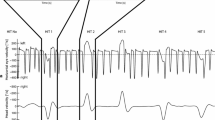Abstract
In clinical practice, the head impulse test paradigm (HIMP) and the suppression head impulse paradigm (SHIMP) stimulate high-frequency head movements so that the visual system is temporarily suppressed. The two tests could also be useful tools for vestibular assessment at low frequencies: VVOR (visually enhanced vestibulo-ocular reflex) and VORS (vestibulo-ocular reflex suppression). The aim of this study is to analyze the eye movements typically found during VVOR and VORS testing in patients with unilateral and bilateral vestibular hypofunction. Twenty patients with unilateral vestibular hypofunction, three patients with bilateral vestibular hypofunction, and ten patients with normal vestibular function (control group) were analyzed through VVOR and VORS testing with an Otometrics ICS Impulse system. During the VVOR test, patients with unilateral vestibular hypofunction exhibited corrective saccades to the same direction of the nystagmus fast phase toward the healthy side when the head rotates toward the affected side, while patients with bilateral vestibular hypofunction exhibited corrective saccades to the opposite side of head movements to each side. During the VORS test, patients with unilateral vestibular hypofunction seem to exhibit larger corrective saccades to the healthy side when the head was moved to this side, while patients with bilateral vestibular hypofunction did not exhibit corrective saccades during head movements to either side. Our data suggest that the VVOR and VORS tests yield the same diagnostic information as the HIMP and SHIMP tests in unilateral and bilateral vestibular hypofunction, and can contribute to the diagnosis of a peripheral vestibular loss as well as the affected side.


Similar content being viewed by others
References
Leigh RJ, Zee DS. The neurology of eye movements. 5th ed. Oxford: Oxford University Press; 2015.
Wong AMF. Eye movement disorders. Oxford: Oxford University Press; 2007.
Gresty M, Leech J. Coordination of the head and eyes in pursuit of predictable and random target motion. Aviat Space Environ Med. 1977;48:741–4.
Kingma H, Van de Berg R. Anatomy, physiology, and physics of the peripheral vestibular system. Handb Clin Neurol. 2016;137:1–16.
Strupp M, Brandt T. Vestibular neuritis. Semin Neurol. 2009;29(5):509–19.
Zuma e Maia FC, Cal R, D’Albora R, Carmona S, Schubert MC. Head-shaking tilt suppression: a clinical test to discern central from peripheral causes of vertigo. J Neurol. 2017;264(6):1264–70.
Halmagyi GM, Chen L, MacDougall HG, Weber KP, McGarvie LA, Curthoys IS. The video head impulse test. Front Neurol. 2017;8:258.
Macdougall HG, McGarvie LA, Halmagyi GM, Rogers SJ, Manzari L, Burgess AM, et al. A new saccadic indicator of peripheral vestibular function based on the video head impulse test. Neurology. 2016;87(4):410–8.
Weber KP, Aw ST, Todd MJ, McGarvie LA, Curthoys IS, Halmagyi GM. Head impulse test in unilateral vestibular loss: vestibulo-ocular reflex and catch-up saccades. Neurology. 2008;70:454–63.
Halmagyi GM, Gresty MA. Clinical signs of visual-vestibular interaction. J Neurol Neurosurg Psychiatry. 1979;42:934–9.
Rey-Martinez J, Batuecas-Caletrio A, Matiño E, Trinidad-Ruiz G, Altuna X, Perez-Fernandez N. Mathematical methods for measuring the visually enhanced vestibulo-ocular reflex and preliminary results from healthy subjects and patient groups. Front Neurol. 2018;9:69.
Zee DS, Jareonsettasin P, Leigh RJ. Ocular stability and set-point adaptation. Philos Trans R Soc Lond Ser B Biol Sci. 2017;372:20160199.
Han BI, Song HS, Kim JS. Vestibular rehabilitation therapy: review of indications, mechanisms, and key exercises. J Clin Neurol. 2011;7:184–96.
Schubert MC, Zee DS. Saccade and vestibular ocular motor adaptation. Restor Neurol Neurosci. 2010;28:9–18.
Funding
KPW acts as an unpaid consultant and has received funding for travel from Otometrics.
Author information
Authors and Affiliations
Corresponding author
Ethics declarations
This is a prospective study conducted in accordance with the Declaration of Helsinki and approved by the Research Ethics Committee of Brazilian Lutheran University (ULBRA RS) in Canoas (CAEE 06137012.3.2002.5349). All subjects participated voluntarily and informed consent was obtained from all individual participants included in the study.
Conflict of Interest
The authors declare that there is no conflict of interest.
Additional information
Publisher’s Note
Springer Nature remains neutral with regard to jurisdictional claims in published maps and institutional affiliations.
Rights and permissions
About this article
Cite this article
Ramos, B.F., Cal, R., Carmona, S. et al. Corrective Saccades in Unilateral and Bilateral Vestibular Hypofunction During Slow Rotation Expressed by Visually Enhanced VOR and VOR Suppression: Role of the Cerebellum. Cerebellum 20, 673–677 (2021). https://doi.org/10.1007/s12311-019-01066-w
Published:
Issue Date:
DOI: https://doi.org/10.1007/s12311-019-01066-w




